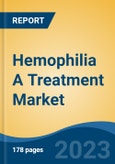Speak directly to the analyst to clarify any post sales queries you may have.
10% Free customizationThis report comes with 10% free customization, enabling you to add data that meets your specific business needs.
The market encompasses a comprehensive range of therapeutic solutions aimed at preventing and managing the potentially life-threatening complications associated with Hemophilia A. One of the key growth drivers is the rising global prevalence of the disorder, coupled with increasing diagnostic capabilities. Enhanced awareness and improvements in genetic and molecular diagnostics have led to a greater number of individuals being accurately diagnosed, thereby fueling demand for advanced treatment options.
Traditional treatment modalities have predominantly relied on intravenous administration of clotting factor VIII, derived either from plasma or recombinant sources. However, the market is undergoing a significant transformation, with growing emphasis on next-generation therapies - notably gene therapy and non-factor replacement treatments. Gene therapy, in particular, holds transformative potential by targeting the root genetic cause of the disease, offering the possibility of long-term or even curative outcomes.
Key Market Drivers
Rising Prevalence and Improved Diagnosis
The growth of the Hemophilia A Treatment Market is closely linked to the increasing prevalence of the disorder and advancements in diagnostic methodologies. Hemophilia A continues to pose a considerable public health burden. According to the World Federation of Hemophilia (WFH), an estimated 179,703 individuals worldwide had been identified with Hemophilia A as of 2023. This increase is largely attributable to greater public awareness, improved diagnostic tools, and expanded genetic testing.The WFH has outlined a five-year strategic objective (2020-2025) to increase global diagnosis by 60,000 cases, reflecting a 25% growth. Enhanced diagnostic capabilities, including molecular and genetic testing, now allow for earlier and more accurate detection of the disorder. Early diagnosis enables personalized treatment approaches, thereby improving patient outcomes and driving innovation in the development of gene-targeted therapies.
In a landmark development, the U.S. Food and Drug Administration (FDA) approved Roctavian in June 2023 - the first AAV-based gene therapy for adults with severe Hemophilia A - marking a major milestone in therapeutic advancements.
Key Market Challenges
High Cost of Treatment
The high cost of treatment remains a significant barrier to widespread adoption and accessibility within the Hemophilia A Treatment Market. Managing the disorder requires lifelong therapeutic intervention, placing a substantial financial burden on both patients and healthcare systems.One of the principal cost drivers is factor replacement therapy, which involves complex and costly manufacturing processes. Patients often require frequent infusions - sometimes multiple times per week - exacerbating the financial strain. While extended half-life products offer the benefit of reduced infusion frequency, their higher price point offsets potential savings.
Gene therapy, although promising, also introduces new cost challenges. The production of viral vectors and genetic manipulation processes involved in gene therapy are resource-intensive, resulting in exceptionally high treatment costs. These economic factors present a major constraint on broader market accessibility and adoption.
Key Market Trends
The Emergence of Gene Therapy
Gene therapy is revolutionizing the treatment paradigm for Hemophilia A. By introducing functional factor VIII genes into the patient’s cells, gene therapy targets the genetic basis of the disorder and offers a potential long-term or curative solution.This therapeutic approach eliminates or significantly reduces the need for regular factor infusions, thereby improving patients' quality of life and easing the treatment burden. Gene therapy has demonstrated promising results in clinical trials, showing the ability to sustain elevated levels of factor VIII and reduce the incidence of spontaneous bleeding episodes.
Furthermore, gene therapy addresses several of the chronic challenges associated with traditional treatments, such as inhibitor development and treatment non-compliance. Its one-time or infrequent dosing regimen enhances patient adherence and convenience, making it a game-changing development in the market.
Key Market Players
- Takeda Pharmaceutical Company Limited
- Sanofi Corporation
- Genentech USA, Inc.
- Novo Nordisk
- Pfizer Inc.
- CSL Behring LLC.
- Grifols
- Sagent Pharmaceuticals
- Octapharma USA Inc.
- UBI Pharma Inc.
Report Scope:
In this report, the Global Hemophilia A Treatment Market has been segmented into the following categories, in addition to the industry trends which have also been detailed below:Hemophilia A Treatment Market, By Treatment Type:
- Factor Replacement Therapy
- Non-Factor Replacement Therapies
- Gene Therapy
Hemophilia A Treatment Market, By Route of Administration:
- Intravenous
- Oral
- Nasal
Hemophilia A Treatment Market, By Distribution Channel:
- Hospital Pharmacies
- Retail Pharmacies
- Online Pharmacies
Hemophilia A Treatment Market, By Region:
- North America
- United States
- Canada
- Mexico
- Europe
- France
- United Kingdom
- Italy
- Germany
- Spain
- Asia-Pacific
- China
- India
- Japan
- Australia
- South Korea
- South America
- Brazil
- Argentina
- Colombia
- Middle East & Africa
- South Africa
- Saudi Arabia
- UAE
Competitive Landscape
Company Profiles: Detailed analysis of the major companies present in the Global Hemophilia A Treatment Market.Available Customizations:
With the given market data, the publisher offers customizations according to a company's specific needs. The following customization options are available for the report.Company Information
- Detailed analysis and profiling of additional market players (up to five).
This product will be delivered within 1-3 business days.
Table of Contents
Companies Mentioned
- Takeda Pharmaceutical Company Limited
- Sanofi Corporation
- Genentech USA, Inc.
- Novo Nordisk
- Pfizer Inc.
- CSL Behring LLC.
- Grifols
- Sagent Pharmaceuticals
- Octapharma USA Inc.
- UBI Pharma Inc.
Table Information
| Report Attribute | Details |
|---|---|
| No. of Pages | 186 |
| Published | April 2025 |
| Forecast Period | 2024 - 2030 |
| Estimated Market Value ( USD | $ 9.51 Billion |
| Forecasted Market Value ( USD | $ 13.68 Billion |
| Compound Annual Growth Rate | 6.2% |
| Regions Covered | Global |
| No. of Companies Mentioned | 10 |









